Review for Utawarerumono: Volume 3 - A Haunted Past
Introduction
Anticipation can be very sweet. Often the act of waiting for something can be even more enjoyable and rewarding than the thing itself, which turns out to be anticlimactic. Why else would people recommend the journey over the destination? Even when it comes to DVD and entertainment, a little anticipation is a good thing, especially when the rewards are worth it. I may have waited 25 years for the definitive release of Blade Runner, but when it came, boy did I relish that DVD collection. But, I have decided that some things are better off delivered in short order, and top of that list is serialised television anime. At the most, it should be delivered at an episode a week, just like on the original broadcast, but if it comes to DVD, better to get it in big, hefty chunks, or all in one go. Having seen the first two volumes of Utawarerumono, I realise that if I had to wait two months for each successive volume as fans would have had to do originally, I would be bald by now, simply through tearing my hair out. I can't explain to you how gratifying it is to have these things available in series boxsets!
Utawarerumono is a fantasy series set in a strange world. It's based on a PC game, but before you recoil in horror, it's one of those narrative adventure PC games that the Japanese are so fond of, barely interactive animated storybooks, with sex scenes. This anime ditches the sex to produce something a little more appropriate for a broader audience. This is a strange world, populated with dog-eared people, strange animals, very real deities, oppressive governments, and on the verge of war. It's in this world that a masked stranger awakes. Hakuoro has no memory of his past, but a mask is affixed to his face, impossible to remove. He wakes in the village of Yamayura, healed and nursed back to health by a young girl named Eluluu, and is taken to heart by the kindly village people. Against all the adversities and challenges this harsh world throws against the people of Yamayura, this noble, enigmatic man becomes a beacon of hope, and a source of strength. But this is just the first step for Hakuoro to take towards his destiny of changing the world.
The next four episodes are presented on this disc from ADV.
11. Everlasting Promise
With the threat of Niwe and Shikeripechim looming on the horizon, Hakuoro is busy making alliances with neighbouring nations, and with the aid of Princess Urutori, the day has come that the treaty will be signed. Which is when Teoro arrives with worrying news. Hot on his heels is an invading army with blood in its eyes, and they aren't Niwe's forces. These are warriors of Kuccha Keccha, and while Hakuoro leads a force to repel them, Teoro's forgotten to mention one very important thing. Having beaten back the attack, Hakuoro attempts to make peace by sending an emissary, only for that emissary to be attacked in turn. With nothing else left to try, the people of Tuskuru must go to war once more. But on the battlefield, Kuccha Keccha's champion, Lady Touka, singles out Hakuoro and issues a challenge. Only she calls Hakuoro the evil Rakshain…
12. Unrest
Touka is the Evankulga of the Kuccha Keccha. The Evankulga are a tribe of awesome warriors who fight solely for justice, and ally themselves with those who deserve that justice. Hence her firm belief that Hakuoro is Rakshain, and Rakshain is the evil man who murdered his own family, leaving Orikakan of the Kuccha Keccha bereft at the loss of his sister and her children. It's a very personal reason to mount an invasion, but wars have started for less, and the Kuccha Keccha cavalry is swift, mobile and effective against the more rigid armies of Tuskuru. Worse, with Hakuoro lacking any knowledge of who he was before Eluluu found him, he has to face the possibility that he is in fact Rakshain.
13. A Bloody Battle
It isn't only Hakuoro who is disquieted by the possibility, now his armies and his subjects are also passing rumour and gossip about why Kuccha Keccha is attacking, and Hakuoro is distracted and withdrawn at the suggestion that he may be a murderer. The only ones certain of his innocence are Eluluu and Aruruu, and the sisters have to remind Hakuoro of who he really is. It means playing hooky from the work of running a nation for a day. But it's a much-needed respite before the big battle, where justice will be decided once and for all. It turns out however that Niwe of the Shikeripechim is tilting the scales of justice.
14. The Ravages of War
The attacks by Shikeripechim intensify, and the toll taken on the outlying villages of Tuskuru increases. Hakuoro remains curiously reluctant to act, even though the recent personal turmoil is behind him. One thing he does do is release Touka from confinement and offers her clemency. She was just as much a dupe as they all were, and he insists that she at least take the Kuccha Keccha king home. Niwe on the other hand continues to scheme and plot, and he has a mysterious winged advisor helping him. The Tuskuru forces continue to put up a bold fight, but when they are as outnumbered as they are, exhaustion and attrition begin to take their toll, and Hakuoro can see only one way out.
Picture
This being a Region 1 disc, Utawarerumono gets a 1.78:1 anamorphic transfer of the NTSC variety. It means a slightly lower resolution than PAL discs, and a greater prevalence of aliasing, but it also means that the image is clear, sharp, and colourful, and the animation is smooth, and free of ghosting and judder. Utawarerumono is an interesting animation, period fantasy as it is, it reminds me somewhat of Inuyasha, with its simplicity of character designs, and wholesome bright, primary colours. That said, there is something of a more atmospheric aesthetic to the animation, it's much more detailed and vivid, and with the fantasy setting, there's something Ghibli-esque about it, reminiscent of films like Nausicaa and Princess Mononoke. All in all, it's a very pleasant show to watch. That's with the exception of crowd and battle sequences. Where there are a lot of people on screen at any one time, and shown at a distance, the animators have used something akin to a 3D RTS graphics engine to render the crowds in CGI, and the graphics do tend to stick out like a sore thumb. Also when the camera gets a little too close, the uniformity of features becomes apparent.
Sound
Utawarerumono comes in DD 5.1 English and DD 2.0 Japanese stereo, along with optional translated subtitles, and a signs only track. In a nice move, the episode titles get a subtitle translation, but in an unconventional font that very much suits the look of the show. The dialogue is clear in both versions, and the show gets some very earthy, folk style music, along with a couple of very pleasant theme songs. I was happy enough with the Japanese version, which had some memorable character voices. Not so much for the English dub, which is pretty run of the mill for anime, not exactly standing out, but not really all that awful either.
Extras
Utawarerumono gets the usual jacket picture and animated menu, and this being a Region 1 disc, it also autoplays with ads for Anime Network and the now dead Newtype USA magazine.
Inside the very shiny green Amaray style case, you can read an eight-page booklet, which offers interviews with Koji Fukazawa, Prop Designer, Tatsue Ozeki, Colour Designer, Japanese voices of Urutori and Camus, Sayaka Oohara, and Rie Kugimiya, and English voice of Eluluu, Kira Vincent Davis.
On the disc you can find a seven-page glossary, explaining the terms used in the show, and detailing some of the characters that you'll encounter.
The Omake Theater returns for this volume, offering another 7 minutes of comedy as Camus and Aruruu play hide and seek.
The Extended Episode Previews are just that, and there are 2 minutes worth here for all four episodes. These previews and the Omake Theater are in Japanese only.
There is a 30 second Character Art Gallery slideshow, as well as the textless credits.
There is a 5-page text interview with Suara, who sings the opening theme song for Utawarerumono.
Finally there are trailers for Moeyo Ken TV, Guyver, Gilgamesh, Diamond Daydream, Misaki Chronicles, and Coyote Ragtime Show.
Conclusion
Utawarerumono certainly isn't unfolding leisurely and with restraint. If anything I'd say that the pace practically hits breakneck here, yet somehow it manages to keep up with character development and moments of introspection. A lot happens, very quickly, yet it never really feels rushed, ill considered, or incomplete. In the space of three volumes, Hakuoro has progressed from amnesiac foundling, to emperor of a major nation, at war with his neighbours. Yes, Utawarerumono is a fantasy series, but there's nothing fantastic about this progression. On the contrary, it feels natural and even plausible. You have some exceedingly good storytelling to look forward to in this third volume, and I am still just as hooked on the series now, as I was when it started two volumes ago, if not more so.
The main theme of this volume boils down to Hakuoro's amnesia. Normally it would just be a gimmick, or the story would progress in a somewhat predictable way of a character trying to regain his or her memories, and uncovering something momentous in the process. The way that Utawarerumono explores this is pretty nifty though, using Hakuoro's amnesia against him when a new enemy of Tuskuru appears, accusing Hakuoro of heinous crimes. These are crimes chilling enough to go to war over, and blood on both sides is spilt in the name of one man's desire to avenge his family. It's a tragic enough affair, and the certainty with which Orikakan pursues his crusade leaves no room for denial or protestations of innocence from his target.
But the insidious thing here is that Hakuoro is an amnesiac, so he has no way of knowing whether Orikakan is telling the truth or not. In fact the first thing is that he is plagued by self-doubt, knowing full well that his past before his waking up in Yamayura is a blank slate. He could very well be the Rakshain that Orikakan pursues, and given his amnesia and Orikakan's account, it seems pretty likely. Hakuoro is wracked by guilt by who he may potentially be, and he's wracked by guilt two-fold in that innocent citizens of Tuskuru are fighting and dying for him, when he may be a murderer. It's no wonder that he becomes plagued by self doubt, it's no wonder that the people around him begin to eye him with distrust, and it's no wonder that disquiet runs through the nation. It's down to Eluluu to believe in him against all rational evidence, and help him hold on to the good man that he is now, rather than give in to his doubts, and the relationship between the two gets stronger in this volume.
Of course, this arc has to have a tragic ending, but it does introduce a couple more characters that will figure in further episodes. There is Niwe's winged advisor, who appears to be an Onkamiyamukai like Urutori, but one who is operating with far darker intentions, weaving dread sorceries in the service of Niwe, and then there is Lady Touka of the Evankulga, who so righteously defends Orikakan's honour on the battlefield, who appears to be just as ideal a match for Benawi, as Karula is for Kurou.
Once again, if Utawarerumono does have a weakness, it is the battle scenes, which is a curious thing to say about a story that revolves around war. But much of Utawarerumono is politics and character development, and actual combat doesn't take up too much screen time. Also when it is one of the major characters that is leading the charge, then it's clear that budget and effort is spent in making them look as good as possible on screen. It's just when it is a series of random extras swinging swords that the budget seems to drain away, and once again the use of CGI models for mid to long distance battle scenes makes the anime look more like a computer game. It becomes random hack and slash, and my interest begins to wane.
Thankfully it's just a small part of the story, and there is a whole lot more to Utawarerumono than meets the eye. It's smart, and it has good deal of depth to it. This third volume merely continues that trend established in the earlier volumes, and as I type this, my thoughts are already turning to volume 4 to find out what happens next.
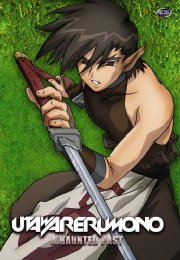
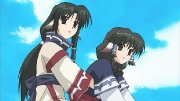
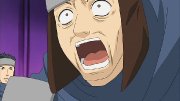

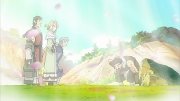

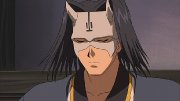
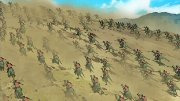



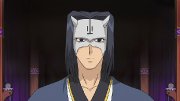
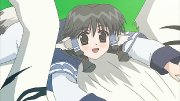
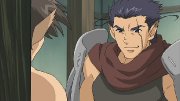
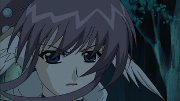

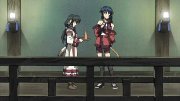
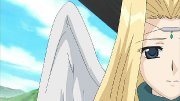
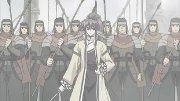

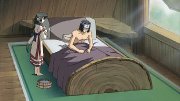
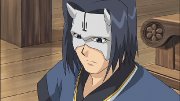

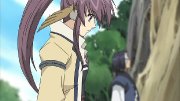
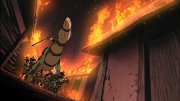
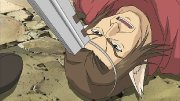


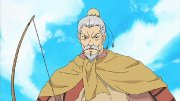
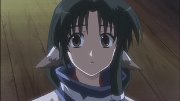
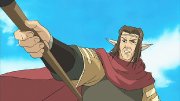






































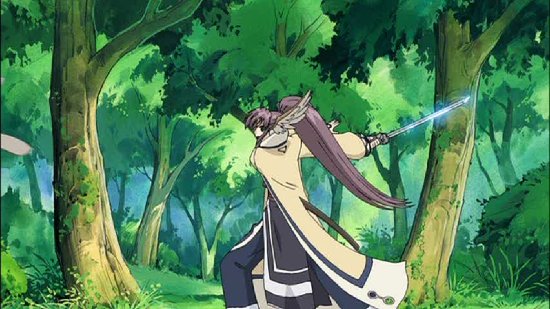


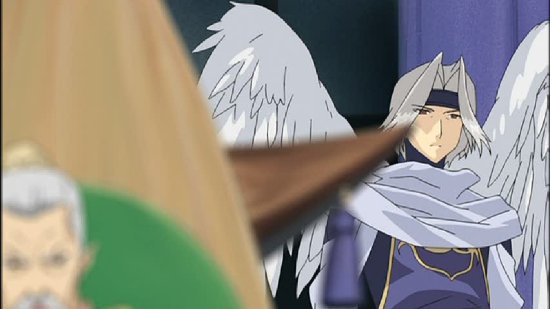

Your Opinions and Comments
Be the first to post a comment!